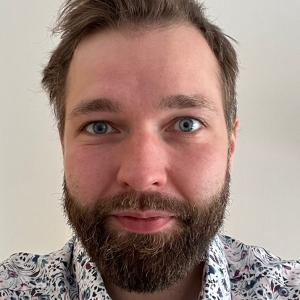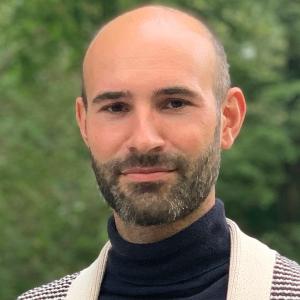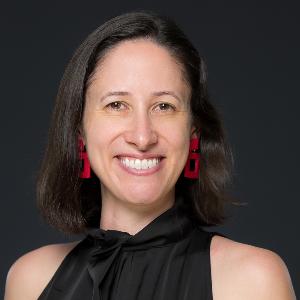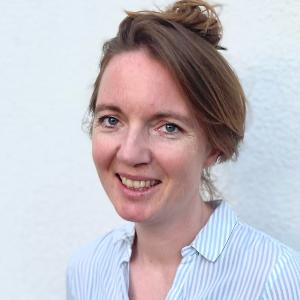Six new ERC Grants at LMU
5 Sept 2024
Millions in funding from Brussels: Six talented early-career researchers have obtained prestigious starting grants from the European Research Council.
5 Sept 2024
Millions in funding from Brussels: Six talented early-career researchers have obtained prestigious starting grants from the European Research Council.
Four talented early-career scientists from various disciplines have each obtained a starting grant together with LMU for their research. Two researchers move to LMU with grants they have acquired with other institutions. Awarded by the European Research Council (ERC), the project grant is worth approximately 1.5 million euros in each case. Winners are chosen based on the scientific excellence of the applicants and of the proposed project. The research grant is among the most prestigious awards of its kind in Europe.

© LMU
Prof. Aaron Bufe is a Professor of Sedimentology at the Department of Earth and Environmental Sciences. The geologist investigates the interaction of processes that shape landscapes, drive the transport of sediments, and modulate global geochemical cycles.
The chemical weathering of rocks controls a variety of biogeochemical cycles. For example, it influences the CO2 content of the atmosphere, offsets CO2 emissions from Earth’s crust and mantle, and stabilizes the climate of our planet. Decades of research have built a knowledge-base on weathering processes that is used to model the evolution of the Earth’s climate over millions of years. However, this knowledge has been limited largely to weathering in mountainous regions, where erosion exposes rocks to chemical weathering. Once these rocks are eroded, they can be re-deposited as sediment, for example in valley fills and floodplains. There, they can continue to weather. Rare estimates suggest that over 50 percent of global weathering may take place outside mountain ranges. Yet, we lack data and models that allow us to quantify weathering fluxes from sedimentary deposits and predict their sensitivity to climate and tectonics.
With his project FloW (Floodplain Weathering), Aaron Bufe wants to close this gap and develop a model for weathering in river sediments. “A quantitative understanding of such weathering processes will allow us to better predict Earth’s response to natural and anthropogenic CO2 disturbances,” says Bufe. He plans to test his model using new data from floodplains influenced by various tectonic and climatic boundary conditions. In this way, he intends to create a novel framework for linking physical and chemical mass fluxes across Earth’s surface and improving our understanding of the carbon cycle and the development of Earth’s climate.

© Tatjana Dierigl
Dr. Markus Dierigl, Senior Researcher at the Arnold Sommerfeld Center for Theoretical Physics at LMU, works in the field of mathematical physics and string theory.
Throughout the history of physics, symmetries have played a pivotal role. This has notably been the case for the theoretical description of experimental observations, when scientists have attempted to capture the changes and dynamics of physical systems. Mathematically, such changes are described via their effect on operators, which produce charged particles for instance. In recent years, our understanding of them has been revolutionized to include their action on extended, rather than point-like, operators, called generalized symmetries.
So far, these symmetries have been mainly discussed in theories without taking the effects of gravity into account. In his new project SymQuaG (Symmetries in Quantum Gravity), Markus Dierigl wants to include gravity and develop theoretical ideas for deriving universal constraints on theories of quantum gravity with generalized symmetries. This combination of generalized symmetries and universal properties of gravitational systems will allow him to utilize the remarkable recent progress in both fields to provide insights into the hitherto unknown laws of quantum gravity, their manifestation in our Universe, and their implications at low energies. The research project will seek a mathematical basis for better understanding the unification of gravity and quantum physics – two theories that are otherwise irreconcilably separate. Next, Markus Dierigl wants to apply these new laws to supersymmetric theories and show that all consistent low-energy supergravity theories necessarily have a string theory origin.

Dr. Sébastien Rivat is Assistant Professor at the Chair of Philosophy of Science. At the Munich Center for Mathematical Philosophy (MCMP) he works on the history and philosophy of physics.
The ideal of a final theory has shaped much of modern physics and its philosophical interpretations. Physicists have used it as a blueprint to construct theories of space, time, matter, and motion that apply in principle everywhere and under any circumstances. Philosophers have used it as a guide to interpret existing theories and depict the entire universe in terms of a bedrock of fundamental entities. Although this ideal still plays an important role today in quantum gravity, the situation has considerably changed since the 1950s. Physicists now widely recognize that our best current theories work only at certain scales, and that this may well be the case for any future empirically successful theory. Physicists also spend most of their time studying systems scale by scale and analyzing how physical effects depend on each other across scales, even in the context of quantum gravity. How should philosophers adjust their interpretative practice if they are to take this new way of doing physics seriously? What kind of world picture would result from this?
The RESCALE (The Scale Revolution in Physics: Historical and Philosophical Perspectives) project contends that the ideal of a final theory no longer provides a sensible interpretative guide, leaving us with no better option but to depict the universe one scale at a time. More precisely, the project will show through an in-depth integrated historical and philosophical study that physicists’ new scale-based theoretical practice leads us to draw a partial picture of the world structured in a complex hierarchy of overlapping layers across scales, which is largely independent of what may lie beyond.
Besides disclosing a fundamental epistemological transformation in the recent history of science and showing how it forces us to rescale our world picture, this systematic interdisciplinary study at the crossroads of history, philosophy, and physics will have profound implications for our understanding of representation, reduction, realism, and metaphysics at the frontiers of science.

Dr. Anna Schroeder previously worked at the Max Planck Institute for Brain Research and the University of Freiburg and will move to LMU in April 2025 as a Professor of Systemic Neuroscience.
To survive, you must adapt your behavior accurately and rapidly to your environment. In a world where our physiological needs and surrounding environment are ever changing, one wrong move could make the difference between life and death. How does the brain successfully compute changes in internal state and external cues, while factoring in experience, to drive the most appropriate behavioral outcome from moment-to-moment?
Mounting evidence suggests that the zona incerta, a little studied brain region, is a central switchboard for such adaptive behavior. This subthalamic nucleus has widespread connections and was recently found to regulate an astounding range of behaviors critical for survival including defense, sleep, feeding and much more. It also encodes associated changes in internal states, such as anxiety, fatigue and hunger, and integrates sensory inputs across modalities. These features suggest that a central function of the zona incerta might be to locally compute needed transitions in behavior based on internal state changes, which are then broadcast to downstream targets to convert this into action.
Anna Schroeder will address this hypothesis in her project CERTASTATES (internal state drivers of behavioral flexibility and their underlying neural circuitry in the zona incerta). To achieve this, she will employ cutting-edge molecular, circuit tracing, recording and in vivo imaging technologies in mice together with diverse behavioral paradigms and rich behavioral state readouts. The ultimate objective is to uncover how distinct internal state changes are processed in defined cell types and circuits, how they drive behavioral flexibility and how they are influenced by deep brain stimulation, motivated by the fact that the zona incerta is one of few established targets in humans for this therapeutic approach. Together, this work will advance our understanding of how neural circuits generate internal states, and in turn process, broadcast and use this information to guide adaptive behavior. Moreover, it will open an entry point for translation by exploring how clinically-applied neuromodulation can transform these vital computations.

© Elvira Kaspar
Prof. Dr. med. Dr. sc. nat. Anna-Sophia Wahl is Professor of Neuroanatomy at the Chair II Anatomy and research group leader in the Institute for Stroke and Dementia Research (ISD) at LMU University Hospital. In addition, she is a member of the SyNergy Cluster of Excellence. Her main research interest focuses on understanding cellular mechanisms of repair in the brain after injury (e.g. a stroke) and how these mechanisms can be further enhanced to promote recovery of lost brain functions.
The brain possesses the remarkable ability to launch self-repair mechanisms after damage – a prerequisite for the restoration of lost functions. In the ARISE (Activate Repair In StrokE) project, Anna-Sophia Wahl wants to discover fundamental principles how the brain orchestrates the cellular response and how it can be further improved. Using state- of the art imaging technology and artificial intelligence, she plans to experimentally discover how individual neurons recode and reconnect after an injury, why some of them take part in repair processes while others do not, and how neural rewiring can be stimulated to promote the recovery of impaired functions.
“With the ARISE project, I will develop a novel experimental strategy to identify cellular mechanisms of neural repair which is the basis to develop novel approaches for chronic impairment after stroke,” says the neuroscientist. To study damage, repair, and behavior in connection with each other, she uses a mouse model she developed especially for this purpose. “This approach will also enable me to apply mathematical models which evaluate the efficiency of novel rehabilitation therapies for strokes and predict their results.”

Prof. Carolin Wendling has been a Professor of Medical Microbiology and Hospital Hygiene at the Max von Pettenkofer Institute since April 2024. Her research focuses on the evolutionary changes in bacteria and their impact on pathogenicity and antibiotic resistance. She secured her grant through Helmholtz Munich, where she will conduct parts of her research.
The global rise in antibiotic resistant bacteria is a significant threat, making the exploration of alternative treatment options essential. One promising approach is the use of bacteriophages, viruses that infect and kill bacteria. However, the wide-spread use of phage-therapy, despite its century-old practice, has not become widely established. This is due to several limitations, among others the time-consuming process of identifying suitable phages and limited in-vivo efficacy of orally administered phages.
With her project PHAGE-PRO (Advancing Phage Therapy through Synergistic Strategies: Phage-Mediated Killing and Competitive Exclusion Using Engineered Prophages), Carolin Wendling aims to overcome these shortcomings by using so-called prophages, viral DNA integrated in bacterial genomes, instead of conventional lytic phages. Wendling will incorporate these prophages into probiotics, thereby enhancing their in vivo efficacy. By leveraging machine learning for phage identification Wendling further aims to establish a platform that will rapidly identify suitable phages. The ultimate core advantage of her innovative approach is the dual action of direct bacterial killing by phages and competitive exclusion by probiotics.
“Although I initially tailored PHAGE-PRO to treat Salmonella infections in poultry, its impact extends far beyond,” says Wendling. “This new technology holds the potential not only to advance infection management in livestock farming, but also opens the door for targeted preventive and therapeutic interventions in human medicine.”